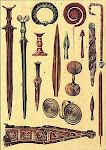In the beginning there were rocks.
Seriously.
The first weapons were used for hunting. Flint was chiseled into arrow heads (a clovis point), the material was strong as steel and sharper. When used with bows, they were powerful enough to pierce a horse from its hindquarters to its heart. The same points were attached to longer wooden shafts to make spears.
The flint knife had serrations along the edge, as the flint would break in predictable ways. Fragments were useful for making tools along with horns and antlers. They were sharpened for cutting leather, and scraping the skins of animals for clothes.
Stone age tools:
Blade core: stone or obisdian used for making different tools by flaking off peices of the core.
End Scraper: used to scrape fur from animal hides.
Burin: stone tool used to carve bone, antler, or wood. Picture a case cutter, but in the stone age the rounded stone piece was the handle while a triangular blade portruded from it.
Awl: used for shredding plant fibers.Antler Harpoon: used for hunting large marine animals. picture a rose stem, instead of the thorns facing the sky, the barbs bent away from the point on the top.
Clovis point: used for killing large animals and cutting plants.Bone flute: used for playing music.Beads: may have been used for currency.
Needle: used for stitching hides.
Bone Point: projectile hunting tool. A deep groove cuts into the base of the point where a wooden shaft was secured with resin.Most stories occur long after this time period, but the resilience of man, and the use of creativity to aid survival is always interesting.
The Bronze age spans the years between 3300 to 1200 BCE. the time period is divided into three stages: early, middle and late. Bronze is an alloy of copper (90%) and tin (10%). The greatest ore sites are located in Britain and central Europe.
Copper and bronze weapons were superior to stone in strength, sharpnes and durability. Historians credit metal weapons with growth of urban civilizaitons by creating a class of skilled metal workers. There was greater contact with scattered people as traders traveled far abroad in search of copper and tin deposits.
With the rise of urban living came the need for armies to protect the area. Those cultures without metallurgy technology fell prey to those that did. The Bronze age covers the time of ancient Greeks, Troy, Assyrians and Egyptians, what we think of as Biblical times. Plagues and famine made some peoples vulnerable to the powerful armies that rose weilding advanced weapons.
Stone age weapons were still used but improved upon. Bows and arrows were widely used in hunting, but in many cultures, it was considered honorable to look into your enemies' eyes on the field of battle.
The sling was still popular for those who might not be able to afford a sword. This weapon worked very well for David when he went up against Goliath. The staff was popular for multiple uses, a bronze tip applied to make a spear.
Swords and daggers could be made to fit the individuals grasp. Arrow heads were now metal and the concept made a fine axe.
Clubs were made with wood, ivory or jade. Some clubs attached to the wrist by a cord threaded through a hole in the club handle. In Hawaii and the Fiji Islands, clubs were embedded with shark teeth or shaped with saw like teeth along the edge. The clubs may also be adorned with the teeth of slain enemies.
The Plains Indians of North America used a long, thin handled stick called a counting coup.
Any blow struck against the enemy counted as a coup, but the most prestigious acts included touching an enemy warrior, with the hand or with a coup stick, then escaping unharmed. It was considered more honorable to risk confronting an enemy without killing him. The coup stick might have notches along the handle so the warrior can keep count of how many enemy he confronted.
The Bronze Age yielded to the Iron age. As weapons became more brutal, its seems humans became more aggressive.
Thursday, March 26, 2009
Subscribe to:
Post Comments (Atom)


No comments:
Post a Comment